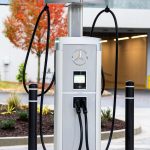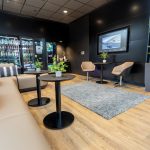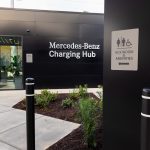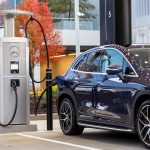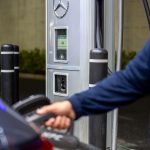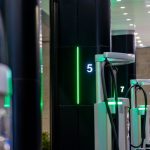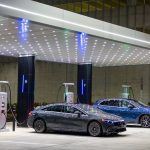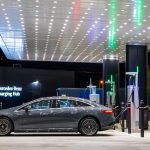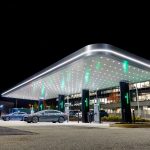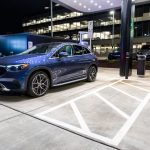
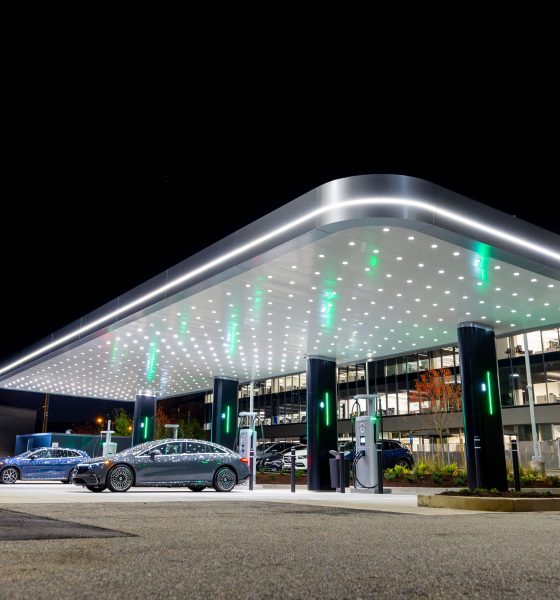
News
Mercedes-Benz launches first North American charging hub for all EV drivers
Mercedes-Benz announced today that it has officially launched the first North American charging hub at its Headquarters in Sandy Springs, Georgia.
The Mercedes-Benz Charging Hub is open to EV drivers of any manufacturer, offering a charging option for drivers outside of the German automaker’s models and expanding options for drivers of electric cars.
The charging hub is the first step in Mercedes-Benz’s commitment to invest over $1 billion in a joint venture with MN8 Energy. The two companies will collaborate to bring 2,500 chargers across at least 400 charging hubs in North America by the end of the 2020s.
“The Mercedes-Benz Charging Network expands global charging options for customers of all EV brands to promote clean, electric mobility,” Chairman of the Board of Management of Mercedes-Benz Mobility AG, Franz Reiner, said.
RELATED: Mercedes-Benz leans on ICE sales to bolster earnings as ‘brutal’ EV sector squeezes margins
“In North America, our strategy is clear: focusing on where EV drivers are and where they are going to enhance the North American EV charging map while setting new standards for quality and customer experience. These efforts will pave the way for greater EV adoption here in North America and around the world.”
The charging hub has several special features that will serve as a benchmark for future charging sites:
- 400kW Chargers: The first chargers installed are provided by ChargePoint and are all capable of charging rates of up to 400kW, offering customers some of the fastest charging speeds in the industry.
- Open to all from day one: Drivers of EVs from any brand can charge their vehicle and enjoy a Mercedes-Benz brand commensurate experience.
- Charging lounge: Charging hub customers can enjoy a premium, clean and comfortable environment while their vehicle charges, complete with couches and lounge chairs, vending machines, refreshments, and restroom facilities.
- Solar Canopy: Provides weather cover for customers, overhead LED lighting for safety and solar panels on top to generate passive clean electricity.
- Intelligent Indicators: A pylon built to a height of 15 feet, visible from the street, indicates the status of the charging stall: in use, free or reserved.
- Accessibility: The charging hub includes one charging spot, closest to the charging lounge, designed especially for handicap-accessible vehicles, as well as one uncovered, drive-through charging spot that is designed for electric vans or EVs with trailers up to 26 feet in length.
- Powered by clean energy: Through both direct and indirect means, the charging hub uses renewable energy and is carbon neutral.
At future locations, Mercedes-Benz said it will have “exclusive lounges” that will integrate a retail setting into a charging location. Charging will be the “backdrop” to grabbing a coffee with friends or recharging yourself while your car does the same.
- Credit: Mercedes-Benz
The partnership with MN8 Energy aims to help the charging hub remain up and running to give those who visit a reliable place to charge their cars. So many EV charging companies have had issues with keeping their chargers maintained, and all too frequently, we see reports of people visiting stalls to charge their cars, but being presented with malfunctioning charging piles.
This is the first of many Mercedes-Benz charging hubs, as we can expect at least sixty of these to come to fruition every year until 2030.
I’d love to hear from you! If you have any comments, concerns, or questions, please email me at joey@teslarati.com. You can also reach me on Twitter @KlenderJoey, or if you have news tips, you can email us at tips@teslarati.com.

Elon Musk
Elon Musk and Tesla AI Director share insights after empty driver seat Robotaxi rides
The executives’ unoccupied tests hint at the rapid progress of Tesla’s unsupervised Robotaxi efforts.

Tesla CEO Elon Musk and AI Director Ashok Elluswamy celebrated Christmas Eve by sharing personal experiences with Robotaxi vehicles that had no safety monitor or occupant in the driver’s seat. Musk described the system’s “perfect driving” around Austin, while Elluswamy posted video from the back seat, calling it “an amazing experience.”
The executives’ unoccupied tests hint at the rapid progress of Tesla’s unsupervised Robotaxi efforts.
Elon and Ashok’s firsthand Robotaxi insights
Prior to Musk and the Tesla AI Director’s posts, sightings of unmanned Teslas navigating public roads were widely shared on social media. One such vehicle was spotted in Austin, Texas, which Elon Musk acknowleged by stating that “Testing is underway with no occupants in the car.”
Based on his Christmas Eve post, Musk seemed to have tested an unmanned Tesla himself. “A Tesla with no safety monitor in the car and me sitting in the passenger seat took me all around Austin on Sunday with perfect driving,” Musk wrote in his post.
Elluswamy responded with a 2-minute video showing himself in the rear of an unmanned Tesla. The video featured the vehicle’s empty front seats, as well as its smooth handling through real-world traffic. He captioned his video with the words, “It’s an amazing experience!”
Towards Unsupervised operations
During an xAI Hackathon earlier this month, Elon Musk mentioned that Tesla owed be removing Safety Monitors from its Robotaxis in Austin in just three weeks. “Unsupervised is pretty much solved at this point. So there will be Tesla Robotaxis operating in Austin with no one in them. Not even anyone in the passenger seat in about three weeks,” he said. Musk echoed similar estimates at the 2025 Annual Shareholder Meeting and the Q3 2025 earnings call.
Considering the insights that were posted Musk and Elluswamy, it does appear that Tesla is working hard towards operating its Robotaxis with no safety monitors. This is quite impressive considering that the service was launched just earlier this year.
Elon Musk
Starlink passes 9 million active customers just weeks after hitting 8 million
The milestone highlights the accelerating growth of Starlink, which has now been adding over 20,000 new users per day.

SpaceX’s Starlink satellite internet service has continued its rapid global expansion, surpassing 9 million active customers just weeks after crossing the 8 million mark.
The milestone highlights the accelerating growth of Starlink, which has now been adding over 20,000 new users per day.
9 million customers
In a post on X, SpaceX stated that Starlink now serves over 9 million active users across 155 countries, territories, and markets. The company reached 8 million customers in early November, meaning it added roughly 1 million subscribers in under seven weeks, or about 21,275 new users on average per day.
“Starlink is connecting more than 9M active customers with high-speed internet across 155 countries, territories, and many other markets,” Starlink wrote in a post on its official X account. SpaceX President Gwynne Shotwell also celebrated the milestone on X. “A huge thank you to all of our customers and congrats to the Starlink team for such an incredible product,” she wrote.
That growth rate reflects both rising demand for broadband in underserved regions and Starlink’s expanding satellite constellation, which now includes more than 9,000 low-Earth-orbit satellites designed to deliver high-speed, low-latency internet worldwide.
Starlink’s momentum
Starlink’s momentum has been building up. SpaceX reported 4.6 million Starlink customers in December 2024, followed by 7 million by August 2025, and 8 million customers in November. Independent data also suggests Starlink usage is rising sharply, with Cloudflare reporting that global web traffic from Starlink users more than doubled in 2025, as noted in an Insider report.
Starlink’s momentum is increasingly tied to SpaceX’s broader financial outlook. Elon Musk has said the satellite network is “by far” the company’s largest revenue driver, and reports suggest SpaceX may be positioning itself for an initial public offering as soon as next year, with valuations estimated as high as $1.5 trillion. Musk has also suggested in the past that Starlink could have its own IPO in the future.
News
NVIDIA Director of Robotics: Tesla FSD v14 is the first AI to pass the “Physical Turing Test”
After testing FSD v14, Fan stated that his experience with FSD felt magical at first, but it soon started to feel like a routine.

NVIDIA Director of Robotics Jim Fan has praised Tesla’s Full Self-Driving (Supervised) v14 as the first AI to pass what he described as a “Physical Turing Test.”
After testing FSD v14, Fan stated that his experience with FSD felt magical at first, but it soon started to feel like a routine. And just like smartphones today, removing it now would “actively hurt.”
Jim Fan’s hands-on FSD v14 impressions
Fan, a leading researcher in embodied AI who is currently solving Physical AI at NVIDIA and spearheading the company’s Project GR00T initiative, noted that he actually was late to the Tesla game. He was, however, one of the first to try out FSD v14.
“I was very late to own a Tesla but among the earliest to try out FSD v14. It’s perhaps the first time I experience an AI that passes the Physical Turing Test: after a long day at work, you press a button, lay back, and couldn’t tell if a neural net or a human drove you home,” Fan wrote in a post on X.
Fan added: “Despite knowing exactly how robot learning works, I still find it magical watching the steering wheel turn by itself. First it feels surreal, next it becomes routine. Then, like the smartphone, taking it away actively hurts. This is how humanity gets rewired and glued to god-like technologies.”
The Physical Turing Test
The original Turing Test was conceived by Alan Turing in 1950, and it was aimed at determining if a machine could exhibit behavior that is equivalent to or indistinguishable from a human. By focusing on text-based conversations, the original Turing Test set a high bar for natural language processing and machine learning.
This test has been passed by today’s large language models. However, the capability to converse in a humanlike manner is a completely different challenge from performing real-world problem-solving or physical interactions. Thus, Fan introduced the Physical Turing Test, which challenges AI systems to demonstrate intelligence through physical actions.
Based on Fan’s comments, Tesla has demonstrated these intelligent physical actions with FSD v14. Elon Musk agreed with the NVIDIA executive, stating in a post on X that with FSD v14, “you can sense the sentience maturing.” Musk also praised Tesla AI, calling it the best “real-world AI” today.
